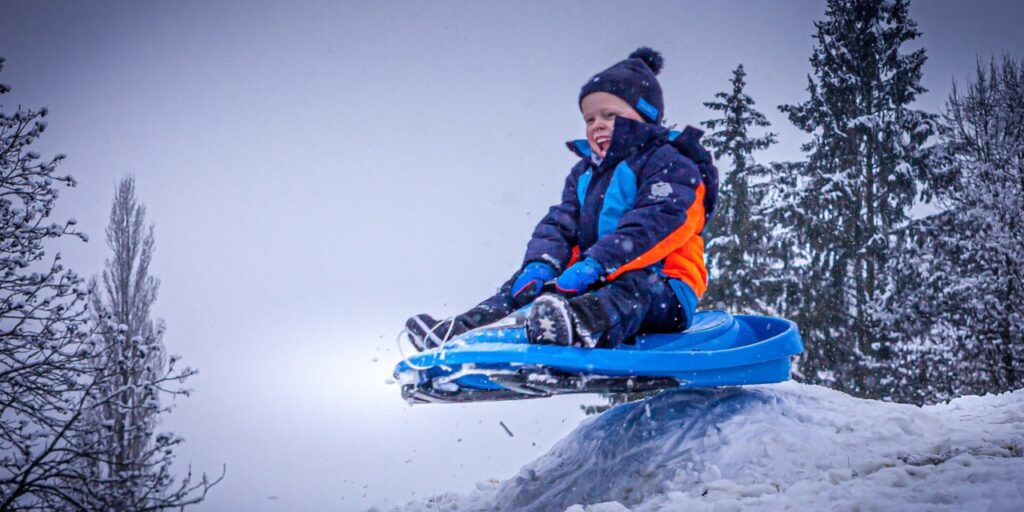- Poorly shovelled sidewalks will lead to slip and falls this winter - December 11, 2024
- Brain injuries are costly on an emotional and physical level - November 22, 2024
- Long-term disability payments could come with a tax liability - October 23, 2024
By Paul Russell, LegalMatters Staff • For many Canadians, one of the great joys of winter is sliding down a hill on a toboggan or sled. But the risk of serious injury may lurk behind the next snow drift, warns Ontario personal injury lawyer Joshua Goldberg.
“We all love the thrill of tobogganing and it is easy to forget how unprotected people are as they glide down the slope on something they really can’t stop or effectively manoeuvre,” says Goldberg, principal of Joshua Goldberg Law. “For that reason, I am not surprised there are many injuries associated with the activity.”
According to a news report, there were 170 tobogganing-related hospitalizations recorded in Canada between 2020 and 2021, according to the Canadian Institute for Health Information, one-third of them involved youths under the age of 10. In comparison, there were 522 injury hospitalizations related to ice skating and 6,590 from falls on ice.
“The risk of injury with tobogganing is pretty low when you look at those numbers on a national scale,” Goldberg tells LegalMattersCanada.ca. “But that is cold comfort to those who do suffer injuries, especially if a municipality’s negligence created conditions that led to the mishap.”
$900,000 award for spine injury
In 2004, a man tobogganing in a reservoir property owned by the City of Hamilton hit a hidden snow-covered drainage ditch on the property, causing serious injury to his spine.
He sued for damages and the case went to arbitration, with the city ordered to pay $900,000, according to a news report.
“That was despite the fact that the city had brought in a bylaw banning tobogganing on the hill, had posted signs about the bylaw, and had tried to fence off the area,” the article notes. “The arbitrator ruled there were not enough signs in the area right around the drainage ditch, and that the fencing had been destroyed and not replaced … the city hadn’t taken enough care to ensure that people on their property were kept safe.”
But Goldberg cautions there have been many other cases where someone injured in a tobogganing accident was unsuccessful with a personal injury claim. For example, in 2014 the Ontario Superior Court released a decision in a case involving a woman who was sledding with her two boys when they hit something in the snow, catapulting her forward and causing her to suffer injuries.
‘Falling off … is also part of that experience’
She sued the Town of Leamington, where staff admitted they knew the property was being used for tobogganing but they did nothing to maintain the area or check for hazards.
In explaining why the town was not liable for her injuries, the court stated “sledding/tobogganing brings with it a foreseeable risk of falls, tumbles and detachment from one’s sled … going down a snow-covered hill in February on a light piece of material (be it plastic, cardboard, Styrofoam or wood) is a typical Canadian winter experience. Falling off a sled is also part of that experience … I find that [she] willingly assumed the known risk that she could be injured.”
- Take steps to reduce liability when hosting a holiday party
- Suing for accident damages? You may be in for special attention
- Cyberbullying is a crime and should not be tolerated
The City of Toronto lists 29 parks where tobogganing is permitted. These parks are inspected on a regular basis for hazards. In neighbouring Oshawa, a proposal to ban tobogganing in all but two city parks generated a wave of public pushback, with councillors voting it down in late January.
“Residents … told the city to ‘stop being a Grinch’ and turning two-year-olds into ‘criminals,’ states a news report. It adds that the proposed ban was sparked by insurer’s report that pointed out certain liability risks if someone suffered an injury on a hill identified as risky. Instead of the blanket ban, the city decided to post more warning signs on those hills, the story states.
Tips for safe tobogganing
Most tobogganing injuries are preventable, says Parachute, a national Canadian charity dedicated to injury prevention. It offers these tips to prevent injury while sliding down the slopes:
- Use only proper equipment. Inner tubes and plastic discs are not recommended because they are difficult to control
- The safest position while tobogganing is kneeling. Laying flat on the back increases the risk of injuring the spine or spinal cord.
- Wear a ski helmet.
- Look for a hill that is not too steep (less than 30 degrees is recommended for children).
- Young children should always be supervised by an adult and should not toboggan at night.
- If multiple people are using the same hill, be mindful of others when timing your descent and move quickly out of the way at the bottom.
“If you fall off a toboggan or another toboggan collides with you, you will have no basis to launch a claim because those are inherent risks of the activity,” says Goldberg. “But if there are hidden hazards that participants are not aware of, that may indicate there was negligence on the part of the municipality.
“In those cases, you may have a good case to claim damages,” he adds.

